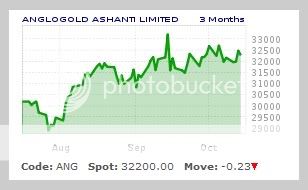Invisible
Robot
- Feb 11, 2006
- 9,075
- 7,878

PART of AngloGold Ashanti's drive to increase production to 6-million ounces a year by 2013 is the improved performance from its Tanzania gold mine, Geita, which had been marked for possible sale, but has undergone a remarkable turnaround.
When Mark Cutifani was appointed CEO of the worlds third-largest gold miner in 2007, one of his first tasks was to review the assets. Geita, which was a loss making mine in northwest Tanzania near Lake Victoria, was earmarked as a fix or sell asset.
Graham Ehm, who heads the Australasian division, was tasked with fixing the mine and he brought senior staff from Anglo- Golds Sunrise Dam mine in Australia to help. Sunrise is a large opencast mine that has begun underground mining.
We are five quarters into a fairly major turnaround so we still feel a bit vulnerable and we really need to keep our focus, Mr Ehm said at the mine this week. Geita was not delivering but now it is rearticulating its position as one of the companys prime assets.
Geita is set to increase annual output to 500000oz next year and sustain it at that level from this years forecast of 355000oz and last years 272000oz. At that output, the mine is second in the AngloGold stable to Mponeng in SA. Mponeng produced 520000oz last year.
The higher output will come from improved grade being fed into the processing plant, which was one of the weak points at the mine. Efforts are being made to get the two mills to perform more reliably. The grade will rise to 3g a ton from 2,5g as mining resumes on a high-grade area of the Nyankanga pit, which was covered when a pit wall slipped.
The feed to the plant will stay steady at 5-million tons a year.
As the reef becomes harder the deeper the Nyankanga pit goes, management is considering installing a third crusher at a cost of 5m to come on line in the first half of next year. The crushers reduce the size of rocks coming into the plant before they are fed into the mills. A third crusher will ensure a more consistently sized feed for the mills, said Jeremy Short, the plant manager.
Geita management will start a pre-feasibility study next year into developing an underground mine at Nyankanga as the pit reaches the end of its economic life.
There is an option, called Cut 8, to make the pit larger. The work we are doing now suggests we go underground rather than do Cut 8, Mr Ehm said.
It will take 18 months to reach a decision on the underground option. Nyankanga supplies Geita with about 80% of its gold.
Geita is bringing the mothballed Star and Comet pits back into production next year and they will start contributing to production from 2012 after a year of waste removal to expose the ore body. These pits could contribute up to 20% of production.
Exploration was cut back during the period of losses. Now that the mine is profitable, the geology team wants to add 3,66-million ounces of reserves in five years, said geologist Steven Robins.
Writter's email: seccombea@bdfm.co.za